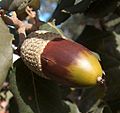Cork oak facts for kids
Quick facts for kids Cork oak |
|
|---|---|
 |
|
| Cork oak, showing the dark reddish bark shortly after harvesting (Algarve, Portugal) | |
| Scientific classification | |
| Kingdom: | |
| Division: | |
| Class: | |
| Order: | |
| Family: | |
| Genus: | |
| Binomial name | |
| Quercus suber |
|
The cork oak (Quercus suber) is a special type of oak tree. It stays green all year round, which means it's an evergreen tree. You can find it growing in southwest Europe and northwest Africa.
This tree is famous for its thick, corky bark. This bark is harvested to make cork, which is used for many things, like bottle stoppers. Harvesting the cork doesn't hurt the tree. A new layer of cork grows back, making it a truly renewable resource.
Contents
What is the Cork Oak?
The cork oak can grow up to 20 meters tall, but it's often shorter in its natural home. Its leaves are about 4–7 cm long. They are dark green on top and lighter underneath. The tree also produces acorns, which are about 2–3 cm long.
These trees can live for a very long time, usually between 150 and 250 years.
Where Cork Oaks Grow
Cork oaks are grown in many countries. The biggest areas are in Spain, Portugal, Algeria, Morocco, France, Italy, and Tunisia. Together, cork oak forests cover about 2.5 million hectares in these countries.
Portugal is the biggest producer of cork in the world. It provides half of all the cork harvested globally. In Portugal, it's against the law to cut down cork oak trees. They can only be cut down for forest management if they are very old and no longer produce much cork.
Harvesting Cork
The first time cork is harvested from a tree is usually when the tree is about 25 years old. This first cork is called 'virgin cork'. After that, you have to wait another 10–12 years for the next harvest. A single cork oak tree can be harvested about a dozen times in its long life.
It's amazing to know that cork harvesting is done entirely by hand. No big machines are used!
Uses of Cork
The cork industry in Europe produces a huge amount of cork every year. It's about 340,000 tonnes of cork, worth about €1.5 billion. Around 30,000 people work in this industry.
While wine corks make up only 15% of the cork used by weight, they bring in 66% of the money. This shows how valuable wine corks are.
Sometimes, cork oaks are planted by themselves. They can provide a small income for their owners. People also plant them just because they are beautiful trees.
Acorns and Animals
Acorns are the seeds of the cork oak tree. They usually fall to the ground near the base of the tree. These acorns can grow into new trees over time. However, many animals, like rabbits, eat acorns as food.
Scientists have studied how animals eating acorns affects new cork oak trees. Even if an acorn is partly eaten, it can still grow if the important parts inside are not damaged. The cotyledon is a very important part of the acorn. It helps the young plant get energy and grow its first leaves. If the cotyledon is damaged, the acorn might not grow as well.
Soil and Growth
The type of soil an acorn grows in is very important. Scientists often study how plants grow in soil that has lots of nutrients compared to soil that doesn't have many.
Cork oak acorns grow much better in soil that is rich in nutrients. This means they have a better chance of becoming strong, healthy trees when the soil is good.
Images for kids
-
Cork oak savanna
-
The Iberian lynx, a resident of the cork oak forests of the southern Iberian Peninsula
See also
 In Spanish: Alcornoque para niños
In Spanish: Alcornoque para niños



















